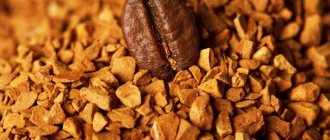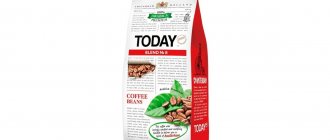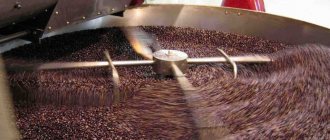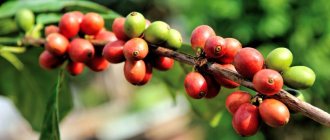Invention of instant coffee
The history of this drink began at the beginning of the 20th century in America. In fact, the idea of creating instant coffee belongs to the Japanese-American scientist Satori Kato , who invented the method for producing this product.
But practically it was George Constant Washington , an American entrepreneur and inventor who lived for some time in Guatemala and was engaged in agriculture, who invented the technology for producing instant coffee on an industrial scale. Upon returning to America in 1909, Washington founded his own business and launched Red E Coffee, the first commercially produced instant coffee. Washington's company subsequently became the main supplier of coffee to the American Army during and after World War I. But despite the success of the business, the quality and unpleasant taste of early instant coffee were noted.
More extensive research into creating instant coffee as we know it today began in the 1930s in Brazil, which was (and remains to this day) the world's largest producer and importer of coffee. The problem was that for several years Brazil had been faced with an overproduction of green coffee. After drying and initial processing, millions of bags of coffee beans remained unclaimed, and it was very difficult to store them for a long time. Therefore, the Brazilian government decided to turn to the Swiss leadership with a request to help solve the problem of surplus coffee crops.
Max Morgenthaler at Nestlé, was tasked with creating a way to preserve and process coffee beans. After four years of scientific research and practical testing, Nestle decided to stop the experiment and closed the project. But Morgenthaler did not give up, continuing to work on creating a “coffee cube” technology that would withstand long-term storage and turn into a drink after adding hot water, while maintaining the properties of the coffee beans.
In his free time after work, Morgenthaler, purchasing coffee with his own funds, continued to create instant coffee. Two years later, in 1936, Morgenthaler was finally able to capture the aroma of coffee, which had previously been lost during the processing of beans, and transfer it to the final product.
As a result, in 1938, in industrial conditions, soluble coffee powder was first produced, called “Nescafé” , and subsequently became incredibly popular throughout the world.
Bushido Original
Price 550 rubles.
Next in the ranking of the best instant coffee is Bushido Original from a Japanese company. Initially, the variety was produced only for its own market, but over time the geolocation of sales expanded significantly.
The grains for the final product are grown in South America, so Bushido Original will delight you with its rich shade, pronounced aroma, and harmonious balance.
Pros:
- Original multi-colored granules that dissolve in a few seconds.
- No bitterness or sourness.
- A good quality glass jar with a raised mark.
- Dense membrane at the neck.
Minuses:
- The highest price on the market.
Methods for producing instant coffee
The whole essence of making instant coffee comes down to the following technological processes:
- Roasting green coffee beans;
- Grinding roasted coffee;
- Treatment of ground coffee with hot water, or extraction, i.e. brewing coffee.
These stages of the technological process are similar to how coffee is prepared at home, only this happens on an industrial scale. Next, the resulting coffee extract is filtered, separated from the grounds, and dried. That is, the last stage of the technological process is drying, which determines the type of instant coffee obtained. Thus, it can be of the following types:
- powder _ This coffee is produced using spray dry technology, “spray drying”. The coffee extract is sprayed into a stream of very hot air and dries into a powder;
- granular _ This type of coffee is produced from powdered coffee, which is made by spray drying, adding another step to the technological process - aggregation, which, in essence, is the wetting of coffee powder to form granules. Such granules then, during storage of the finished product, can again disintegrate and turn into powder;
- freeze-dried . This coffee is produced using freeze dry technology, “freeze drying”. The coffee extract is frozen, then crushed into small crystals, and then dehydrated by sublimation in a vacuum. After the water evaporates, the dry extract retains its crystal form, acquiring a caramel color.
This manufacturing method best preserves the flavor and aromatic substances of the coffee extract, but due to the fact that this technology is the most energy- and labor-intensive, freeze-dried instant coffee is more expensive than powdered and granulated coffee.
Best Quality Ground Coffee Substrates for 2021
According to numerous studies, the most delicious drinks are obtained when purchasing coffee of this category. Popular models of mixtures among the population are of foreign and domestic origin. Well-known brands include:
- Bushido;
- Lavazza;
- Jacobs.
produces 5 varieties of goods. The main containers for mixtures are glass jars. The cost, depending on the composition of the product, varies from 250 to 1,600 rubles. The TOP includes one product item that has earned the trust of thousands of customers.
The Lavazza company has been on the market for more than a century, producing a huge number of elite coffee varieties, but only a few are represented in Russia. In most cases, tin cans are used as containers. The price segment for this category of coffee starts from 390 rubles.
The Jacobs company is one of the largest in the Russian sales market. Its only competitor is Carte. The company itself comes from Finland, but there are 3 factories producing the drink in Russia. The manufacturer’s assortment is huge, as is its experience (about 100 years on the market). Delivery is carried out both in glass and tin, and in packaged containers. The price segment is varied, but accessible to everyone.
Kodo from the manufacturer Bushido
The Swiss brand has gained popularity among gourmets and novice coffee lovers due to its unusual taste (shades of nutmeg and dark chocolate). The mixture combines instant and ground coffee, the raw materials for which are sourced from Ethiopia and South America. Natural Arabica beans are processed using modern In-Fi technology.
Packaging and appearance of Kodo coffee granules from the manufacturer Bushido
Main characteristics:
| Net weight: | 95 grams |
| Packing material: | glass |
| How many spoons per cup: | 2 pcs. |
| Manufacturer country: | Switzerland |
| Shelf life: | 1.5 years |
| Implementation: | Japan, Russia |
| Price: | 500 rubles |
Coffee Bushido Kodo
Advantages:
- Ergonomic packaging;
- Invigorates;
- Lots of positive reviews;
- The smell and taste are like freshly brewed natural coffee.
Flaws:
- Expensive;
- Presence of sediment.
Prontissimo Intenso from the manufacturer Lavazza
To prepare the coffee mixture, natural Arabica beans are used, which are well roasted (a dark color is formed). The product contains 90% instant and 10% ground coffee. How to prepare the drink correctly is indicated in the instructions.
Tin can of Prontissimo Intens coffee from the manufacturer Lavazza, appearance
Main characteristics:
| Net weight: | 95 grams |
| On the market: | since 1895 |
| Roasting: | dark |
| Packing material: | in a tin can |
| Number of cups per jar: | 52 pcs. |
| Production: | Italy |
| Country of origin: | Colombia |
| Average price: | 390 rubles |
Coffee Lavazza Prontissimo Intenso
Advantages:
- Dissolves well, leaves no sediment;
- Tart aftertaste;
- Soft smell.
Flaws:
- Price.
Monarch Millicano from Jacobs
Coffee is made from two types of beans - Arabica and Robusta, using the method of sublimation. For cooking, use coarse grinding with a medium degree of roasting. By introducing advanced technologies, the company has ensured that each granule contains particles of whole grains (ultrafine grinding).
Monarch Millicano coffee from Jacobs, packaging + brewed drink
Main characteristics:
| Net weight: | 95 grams |
| Package: | glass jar |
| Origin: | Finland |
| Production: | Russia |
| Average cost: | 280 rubles |
Jacobs Monarch Millicano Coffee
Advantages:
- Quick cooking;
- Delicious;
- Value for money;
- No sediment;
- Unique aroma.
Flaws:
- Not identified.
Raw materials for the production of instant coffee
Each manufacturer of this product, through advertising, convinces its consumers that only Arabica beans of the highest quality are used to produce instant coffee. But the reality is that if this were true, then the price of instant coffee would be many times higher than that of beans. The price for 100 g of instant coffee is already higher than the cost of the same amount of beans due to the use of energy-intensive processes to produce a soluble analogue of natural coffee. In addition, due to the peculiarities of the technological process for making instant coffee, most of the aromatic and flavoring substances of coffee beans are lost in the process. Thus, using high-quality beans to produce ersatz coffee is not economically profitable.
It is also worth considering the fact that high-grade Arabica beans are bought by roasting companies that produce natural bean coffee. For the production of instant coffee, coffee beans are mainly used that remain unclaimed in the natural coffee market: they have not been sorted for defects, do not have a unique or simply good flavor potential (mediocre grain), sometimes even affected by disease (mold, fungi) or simply beans obtained from unripe coffee berries.
Another source of raw material for the production of instant coffee is robusta . The beans of this type of coffee do not have such a bright taste and aroma as Arabica, but Robusta contains more caffeine, which is even an advantage in cases where a person wants to get not so much taste from a cup of coffee (it can be “masked” with milk or sugar, if it is unpleasant), how much is just a charge of cheerfulness. In addition, Robusta is quite unpretentious in cultivation, which allows you to grow this type of coffee without special costs, unlike Arabica, which ultimately can have a positive effect on the price of the finished product, to which Robusta was added.
Despite some shortcomings, instant coffee has long conquered the market and enjoys well-deserved popularity among consumers. Let the aromatic drink delight you every morning!
UCC The Blend 117
Price 520 rubles.
The delicious UCC The Blend 117 made it into the TOP 10 thanks to the author’s technology for processing raw materials. Intensive and long-term roasting gives instant coffee a rich aroma, a pleasant tart taste with a slight bitterness. Contains 100% Arabica beans grown in Ecuador and Brazil. Beautiful, smooth granules without foreign tones or impurities.
Pros:
- Dense foam when cooked.
- Presentable jar with rounded corners.
- Reliable protective foil.
- Medium roasting.
- Pleasant notes of fruit, velvety aftertaste.
Minuses:
- Not always available in retail stores.
What affects the strength of coffee?
It's safe to say that the strength of the coffee in your cup depends on many factors.
- Type of coffee . Robusta is stronger than Arabica.
- Variety and region of grain growing . African and Arabian varieties are stronger than South American varieties.
- Processing method . Dry processed beans have more caffeine than washed beans, and fermented coffee is stronger than regular beans.
- Roasting degree . Strong roast coffee has a higher caffeine content compared to medium or light roast beans.
- Composition of the blend . Adding Robusta to the blend will make it stronger than a 100% Arabica bean mix.
- Cooking method . Long extraction ensures maximum caffeine saturation of the drink, so coffee in a drip coffee maker may be stronger than in an espresso machine.
- Drink recipe . Add one more teaspoon of powder and your coffee will be much stronger!
- No additives . Milk, cream, and honey dilute the taste and partially neutralize the effect of caffeine.
Don't forget that the safe intake of caffeine is 300 mg per day. Drink strong coffee in moderation, and it will only bring you energy and enjoyment of its rich taste.
Samples studied
The modern invigorating drink was “born” in the mid-20th century. A scientist from Switzerland suggested preserving excess grains.
Every day, about 2 billion black drinks are brewed and drunk around the world. ½ part is an instant drink.
Freeze-dried coffee is prepared in 3 stages:
- freezing;
- dehydration;
- splitting up.
This processing method allows you to preserve the beneficial substances and excellent taste in the invigorating drink.
6 types of famous coffee brands took part in the qualifying round:
- Ambassador.
- Tchibo.
- Nescafe Gold.
- Moccona.
- Jardin.
- Black card.
What blends deserve the title of the strongest coffee?
In addition to single varieties, in the world of coffee there are many blends that are sold in ready-made form.
Which mixtures deserve the title of the strongest?
- Death Wish . Translated as "Dying Wish". It has a caffeine content 1.5 times higher than the strongest espresso. You can buy it at the coffee shop of the same name, which is located in New York, or through online stores. The composition of this mixture is kept strictly secret, but it is considered the strongest in the world.
What can you buy in our coffee shops and stores to cheer you up in the morning?
- Paganini . An espresso blend containing about a quarter of strong robusta. These grains make a thick, rich and invigorating drink. It is considered one of the strongest mixtures.
- Espresso IR . It contains very dark, so-called Italian roasted beans. The finished drink is dark in color, high in caffeine and has a characteristic nutty aroma. This mixture can be found on sale under the name “Italian espresso”.
On supermarket shelves
It is not always possible to get to a specialized coffee store. On supermarket shelves you can also choose the strongest coffee option.
- Blaser Opera . The composition contains Javanese robusta, the strength is enhanced by dark roasting of the grain. An excellent option for a morning espresso or a cup of oriental coffee.
- Blaser Rosso & Nero . It also contains a mix of Arabica and washed Robusta. In addition to the high caffeine content, the taste of this mixture is perceived as particularly strong, thanks to pronounced notes of nuts and dark chocolate.
- Lavazza Grande Ristorazione . A blend with more Robusta than Arabica. Quite strong, albeit harsh taste. Ideal for espresso machines, not so good in a cezve.
- Sumatra Mandheling from Jardin is a single variety that is distinguished by both strength and richness. It can be used to make espresso, but even in a regular Turkish coffee it shows decent results with a high caffeine content.
- Espresso Di Milano Style . A strong blend that invigorates well. Strong roasting of the grain enhances the feeling of strength of the finished drink.











